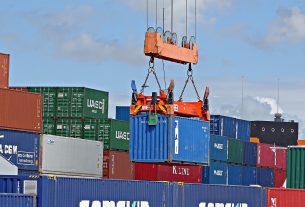Why Are Migrants Seen as a Threat in the U.S. Despite Clear Economic Needs?
The issue of migration in the United States has long been a source of heated debate, often framed by political leaders and media outlets as a crisis or threat. However, this view stands in stark contrast to the demographic and economic realities facing the U.S. today, where labor shortages, aging populations, and vacant towns are becoming increasingly problematic. Migrants could, in fact, play a significant role in addressing many of these issues, from revitalizing struggling communities to expanding the workforce in key sectors.
So why is migration so often portrayed as a problem in the U.S., even when there is clear evidence that the country needs more people to fill labor gaps and breathe new life into declining regions? What barriers exist that prevent a more structured, humane, and lawful approach to migration? To understand this, we need to explore the economic, political, and social forces at play.
The U.S. Demographic and Economic Landscape
The United States is grappling with a major demographic shift. According to the U.S. Census Bureau, the country’s population is aging rapidly. By 2034, for the first time in U.S. history, adults aged 65 and older are projected to outnumber children under 18. This growing aging population is leading to labor shortages across many industries, as there are fewer younger workers to replace retiring Baby Boomers. The problem is particularly severe in rural and depopulated areas, where many communities are struggling with vacant homes and derelict buildings.
In parallel, the U.S. workforce is facing growing challenges in sectors such as agriculture, construction, healthcare, and hospitality, where jobs often go unfilled due to a lack of native-born workers willing to take these positions. According to the Bureau of Labor Statistics, industries such as construction are facing critical labor shortages, with immigrant labor making up a significant portion of the workforce. Without the influx of migrant workers, these industries—vital to the country’s infrastructure—could face serious slowdowns.
Additionally, many of the vacant towns and abandoned properties across the U.S. could benefit from the revitalization efforts brought by migrant communities, many of whom have experience in construction, farming, and small business development. This suggests that migrants not only fill labor gaps but can also help with urban regeneration, especially in economically struggling regions of the country.
The Economic Role of Migrants
Migrants play a critical role in the U.S. economy, contributing significantly to both the labor force and tax base. According to a 2017 report from the National Academies of Sciences, immigrants contribute to economic growth by filling jobs that native-born workers often avoid, particularly in low-wage sectors. Migrants are also more likely to start small businesses, which creates jobs and stimulates local economies. Studies have shown that immigrants are responsible for over 25% of all U.S. entrepreneurs, despite making up only 13% of the U.S. population.
Additionally, the American Immigration Council reports that immigrants contribute approximately $2 trillion to the U.S. economy each year, largely through their roles in healthcare, construction, and manufacturing, as well as by contributing taxes to local, state, and federal governments.
While many politicians frame migrants as a drain on resources, the reality is that they are an integral part of a functioning, competitive economy. The Cato Institute, a libertarian think tank, has argued that immigrants, particularly those who are working age, actually have a positive fiscal impact, helping to fund Social Security and Medicare while contributing to the overall productivity of the economy.
Political and Social Framing: Fear and Misinformation
Despite these clear economic benefits, migration in the U.S. is often framed as a threat by certain political groups and media outlets. Right-wing political leaders have historically portrayed immigrants—particularly those arriving via unauthorized channels—as a danger to national security, jobs, and public services. The rhetoric of a “migrant crisis” is often accompanied by fears of cultural invasion and criminal activity, though studies consistently show that immigrants are no more likely to commit crimes than native-born citizens.
This framing taps into fears about identity, competition for jobs, and the perception that immigration can lead to overcrowding and strained public resources. For example, the rise of the alt-right in the U.S. has helped spread anti-immigrant sentiment, often with the claim that large-scale immigration undermines American values and sovereignty. Additionally, the Trump administration’s “zero-tolerance” immigration policy, which focused on separating families at the U.S.-Mexico border, fed into this fear, creating a climate of hostility toward migrants and refugees.
Moreover, the influence of anti-immigrant lobbies, such as FAIR (Federation for American Immigration Reform) and NumbersUSA, has led to policy proposals that restrict immigration and promote the idea that migrants are taking away jobs from native-born workers. Polls have shown that anti-immigrant sentiments are often based on misinformation and misunderstanding, as many Americans do not fully grasp the economic contributions migrants make.
Institutional and Legal Barriers
While public sentiment and political rhetoric may be one reason migrants are viewed negatively, institutional barriers also play a significant role. Immigration policy in the U.S. is fragmented and often inefficient, making it difficult for migrants to integrate into the labor market. For example:
- Complex and Slow Asylum Process: Migrants seeking asylum often face long wait times and bureaucratic hurdles. According to Human Rights First, the asylum process can take years to complete, during which time migrants are often denied the right to work or support themselves economically.
- Legal Restrictions on Work: Even migrants with legal status—such as H-2A agricultural workers—often face restrictions on the types of jobs they can hold, which limits their ability to integrate fully into the labor market. Additionally, undocumented migrants, even if they are employed in low-wage jobs, often have no path to citizenship, which leaves them vulnerable to exploitation.
- Lack of Comprehensive Integration Programs: There is a lack of coordinated programs designed to help migrants integrate into the workforce and society. Many migrants struggle to get their foreign qualifications recognized, and language barriers can make it difficult for them to find stable employment. Without government-supported language programs, job training, and cultural integration initiatives, it is difficult for migrants to fully realize their potential and contribute to their communities.
The Path Forward: A Strategic Approach to Migration
Given the demographic challenges and labor shortages the U.S. faces, there is a clear opportunity to utilize migrant labor in ways that are beneficial to both migrants and the broader society. A more humane and coordinated approach to migration could help address key challenges:
- Pathways to Employment and Citizenship: The U.S. could create more work visas and pathways to citizenship that allow migrants to contribute legally and securely to the economy. Legalizing undocumented workers who are already contributing to sectors like agriculture and construction would help stabilize these industries.
- Regional Resettlement: Many parts of the U.S. are experiencing population decline or have large numbers of vacant homes and derelict buildings. A strategy could be devised to encourage migrants to settle in these underpopulated areas, where they could help revitalize communities and bring economic development to rural and depopulated regions.
- Support for Integration: The government could invest more in language training, skills development, and community integration programs that help migrants succeed in the U.S. economy and society. Programs that recognize foreign credentials would also help ensure that highly skilled migrants are able to enter professional fields where their expertise is needed.
- Debunking Myths: It is crucial to tackle the misinformation surrounding migration. Education and public awareness campaigns can help shift the narrative from viewing migrants as a threat to seeing them as contributors to the nation’s economy and society.
By recognizing the economic and demographic realities and working to build a legal, humane, and practical framework for migration, the U.S. can turn its migrant crisis into a solution, addressing its labor shortages while revitalizing communities and growing the economy.
References:
- Bureau of Labor Statistics (BLS), 2023. “Labor Force Participation and Workforce Trends.” BLS
- Cato Institute, 2022. “The Economic Benefits of Immigration.” Cato Institute
- American Immigration Council, 2020. “The Contributions of Immigrants to the U.S. Economy.” American Immigration Council
- Human Rights First, 2023. “The U.S. Asylum System: Barriers and Delays.” Human Rights First



